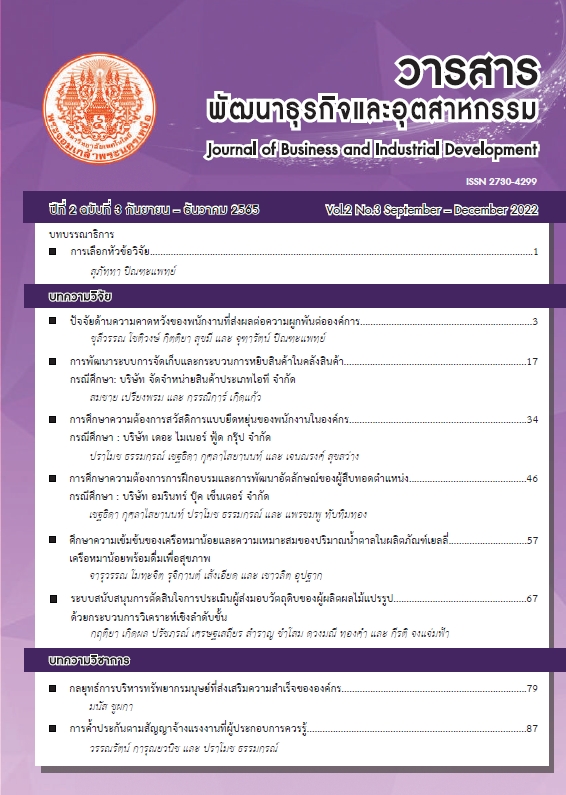Optimization of Krueo Ma Noy Concentration and Sugar Amount in the Health Jelly Beverages
Keywords:
Krueo Ma Noy, Sugar Content, Ready-to-Drink Jelly, Healthy DrinkAbstract
The objectives of this study were 1) to explore the optimal Krueo Ma Noy concentration ratio with water for ready-to-drink gel beverages; 2) to determine the appropriate sweetness in the jelly product, and 3) to assess the experiment results on sensory perception of the product. A randomized complete block design (RCBD) trial was planned to assess sensory quality in terms of appearance, color, smell, taste, texture and overall preference. The 9-Point Hedonic scales were rated by 80 taster participants. The results of the study were as follows: 1) The sensory perceptual test revealed that the tasters accepted the 1:2 concentration formula regarding appearance, color, smell, taste, texture. Average liking scores reached up to 8.05, 7.88, 7.88, 8.08, 8.23 and 8.48 respectively. Statistically significant differences towards product-related preferences were observed at the 0.05 level; 2) According to appropriate sweetness evaluation, the approved sweetness was revealed as 20 percent of the total sugar by the total weight of jelly products. In terms of appearance, color, smell, taste (sweetness), texture and overall liking, the preference rating attained 7.68, 7.59, 7.61, 7.80, 7.75 and 7.80, respectively. The perceived attitude towards these aspects were significantly different (p<0.05). Concisely, the approved ratios of Krueo Ma Noy concentration in jelly is the 1:2 formula with 20 percent of the total sugar weight. This formula is considered suitable for a healthy ready-to-drink Krueo Ma Noy jelly beverage.
References
สุพรรณษา เทียมประสิทธิ์. (2561). ความรู้เบื้องต้นเกี่ยวกับอาหารและเครื่องดื่ม. บริษัท วี. พริ้นท์.
จำลองลักษ์ หุ้น, รุ่งทิพย์ พรหมทรัพย์, อภิสิทธิ์ ประสงสงค์สุข, สุธาสิณี นามบุตร และปราโมทย์ ทองขาว. (2553). JELLY (พิมพ์ครั้งที่ 2). แม่บ้าน.
จริยา เดชกุญชร. (2549). สุดยอดเบเกอรี่. ม.ป.ท.
ประสงค์สม ปุณยอุปพัทธ์. (2555). การผลิตเครื่องดื่มและเครื่องดื่มแอลกอฮอล์. สำนักพิมพ์แห่งจุฬาลงกรมหาวิทยาลัย.
กัญจนา ดีวิเศษ และ อร่าม คุ้มวงษ์. (2541). ผักพื้นบ้าน. สถาบันการแพทย์แผนไทย, กรุงเทพฯ.
สุดารัตน์ หอมหวล. (2553). เครือหมาน้อย. Sutir. http://sutir.sut.ac.th:8080/sutir/handle/123456789/3916
พรประภา ชุนถนอม, กรรณิการ์ สมบุญ, สุดารัตน์ สกุลคู และ อรนุช สีหามาลา. (2556). ผลของวิธีการสกัดต่อคุณภาพของเพคตินจากใบเครือหมาน้อยในเทือกเขาภูพาน. สาขาวิทยาศาสตร์และเทคโนโลยีการอาหาร. คณะเกษตรศาสตร์. มหาวิทยาลัยข่อนแก่น.
กองโภชนาการ กรมอนามัย. (2544). ตารางแสดงคุณค่าทางโภชนาการของอาหารไทย. โรงพิมพ์องค์การทหารผ่านศึก.
วิทยา บุญวรพัฒน์. (2560). 40 สรรพคุณและประโยชน์ต้นกรุงเขมา (เครือหมาน้อย). Medthai. https://www.medthai.com
สำนักงานมาตรฐานผลิตภัณฑ์อุตสาหกรรม. (2542). มาตรฐานผลิตภัณฑ์อุสาหกรรม แยม เยลลี่ และ มาร์มาเลด (พิมพ์ครั้งที่ 2). สำนักงานมาตรฐานผลิตภัณฑ์อุตสาหกรรม.
อบเชย วงศ์ทองและขนิษฐา พูลผลกุล. (2558). หลักการประกอบอาหาร. มหาวิทยาลัยเกษตรศาตร์.
รีดเดอร์ส ไดเจสท์. (2543). รู้คุณรู้โทษโภชนาการ. บริษัทรีดเดอร์ส ไดเจสท์ (ประเทศไทย) จำกัด.
สรจักร ศิริบริรักษ์. (2547). เภสัชโภชนา. ม.ป.ท.
นิธิยา รัตนาปนนท์. (2557). เคมีอาหาร. โอเดียนสโตร์.
Downloads
Published
How to Cite
Issue
Section
License

This work is licensed under a Creative Commons Attribution-NonCommercial-NoDerivatives 4.0 International License.




